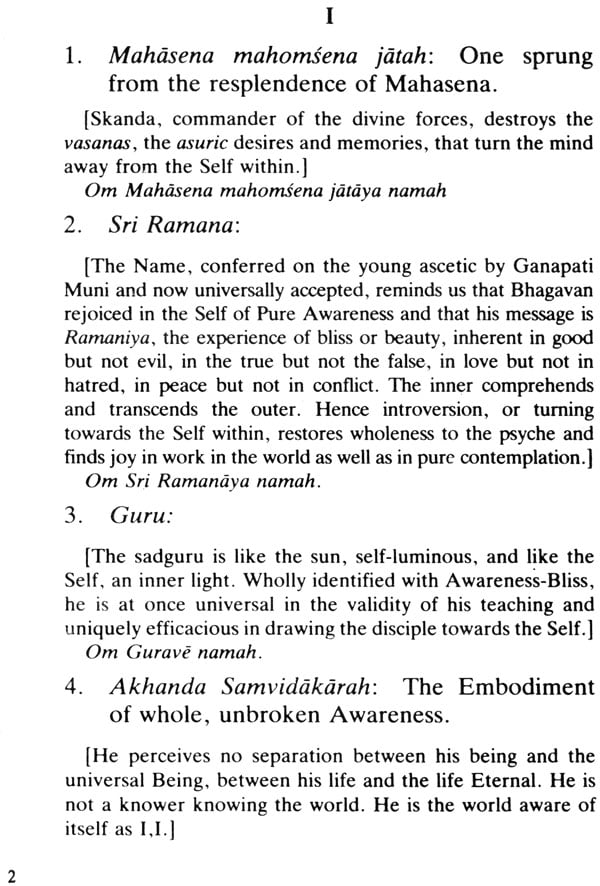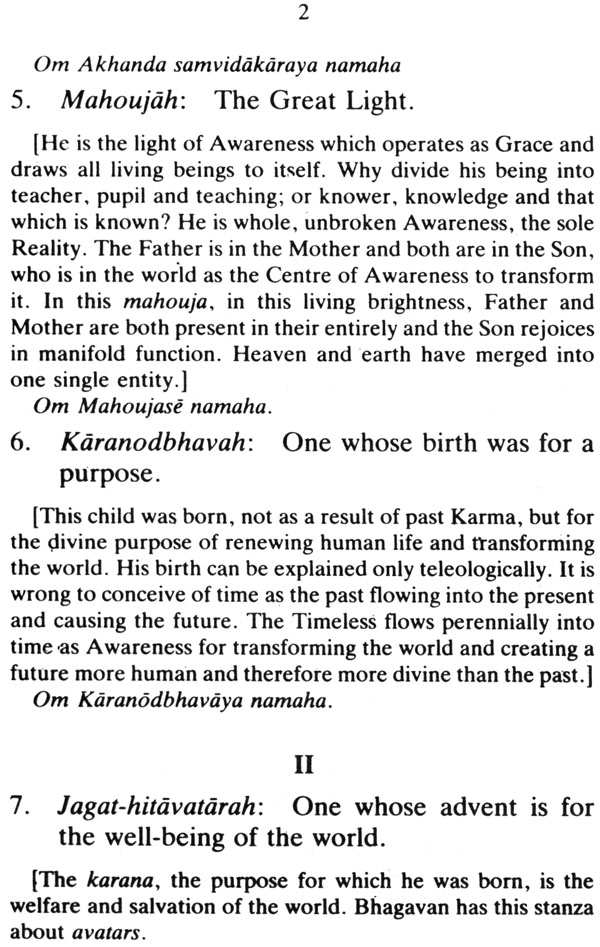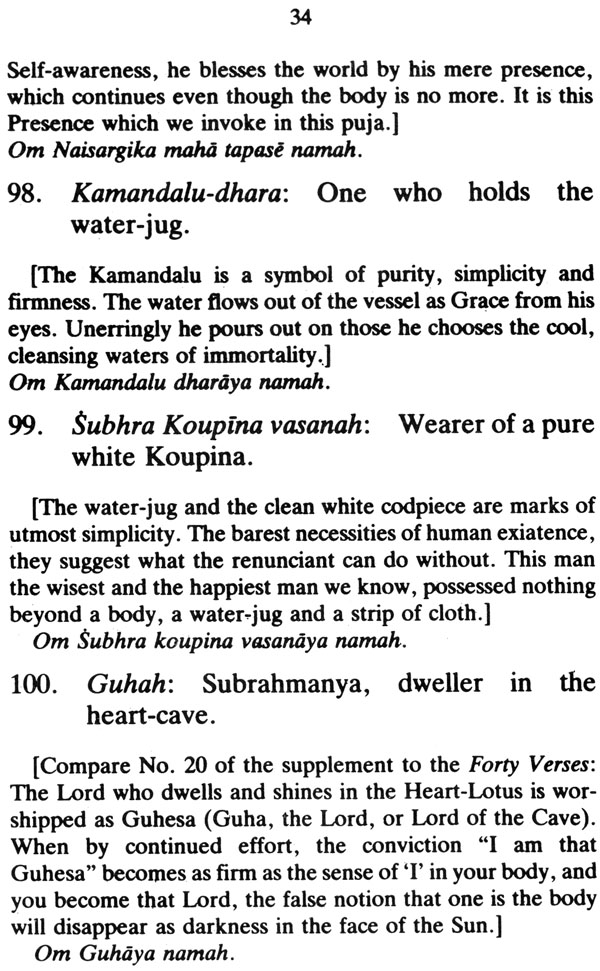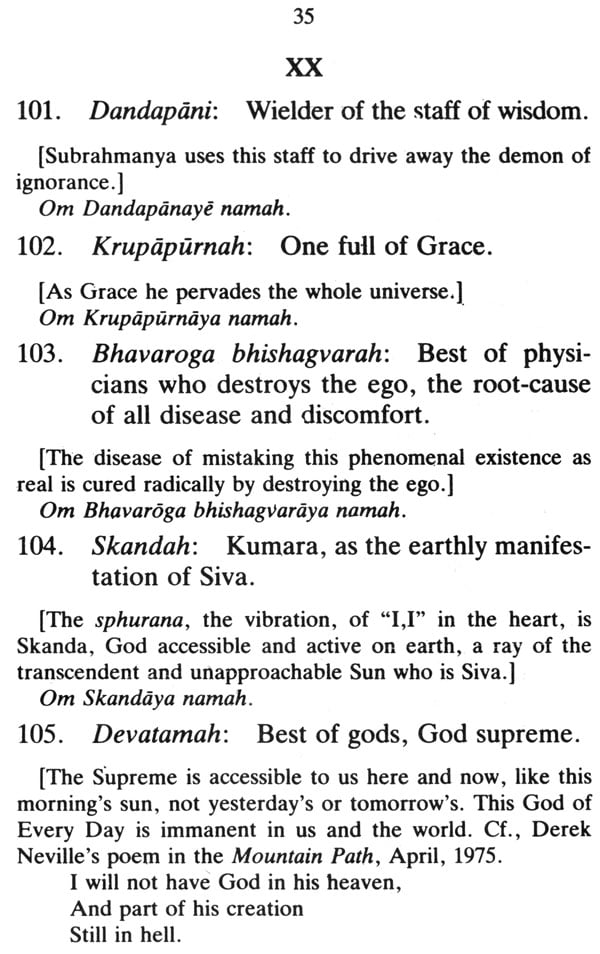
The 108 Names of Sri Bhagavan: ('Ramana Ashtothara')
Book Specification
| Item Code: | IDJ336 |
| Author: | Sri Viswanatha Swami and K. Swaminathan |
| Publisher: | Sri Ramanasramam |
| Language: | English |
| Edition: | 1997 |
| Pages: | 37 |
| Cover: | Paperback |
| Other Details | 7.0 inch X 5.0 inch |
| Weight | 50 gm |
Book Description
Foreword
Ramana Ashtothara is being chanted daily at the Samadhi Shrine of Sri Bhagvan during the Pujas with offerings of flowers, both in the morning and in the evening.
Though Ramana Ashtothara in booklet form, has always been and in available in Sanskrit, for the benefit of devotees a lucid commentary in English on the significance of each Name is brought out for the first time. We are grateful to Professor K. Swaminathan for rendering this service.
In 'Ramana Kendras' and 'Ramana Sat Sangs', Ramana Ashtothara is being chanted as adoration to the Master. Now, devotees have the benefits of chanting these Holy Names with full understanding of their import.
About the Book:
Viswanatha Swami, a great devotee and scholar, composed twenty slokas containing the 108 Names of Sri Bhagavan which are used in formal puja. As each Name is uttered by way of invocation, a flower is offered in worship. The choice and the arrangement of the Names provide an exquisite blend of biography, mythology and loving adoration and thus create the proper atmosphere for devotees invoking and enjoying the Presence of Sri Bhagavan.
What is most evocative about the string of Names is the strong thread, the steady undercurrent, of identity between Bhagavan and Kumara, the son of Siva and the embodiment of heroic youth pointing to and working for a future brighter than the past. This association, hallowed and enriched by Ganapati Muni and Muruganar, suggests without explicitly asserting the profound significance of Bhagavan's advent and its possible impact on the future of mankind.
The creative mystery that binds together God and man, Heaven and earth, spirit and master, purusha and prakriti, is embodied in every human child, father of Man and potential Sage, the seed from which emerge the tree of dharma and the fruit of moksha. No man is mere man. Hew is a tree plus, an animal plus, a bird plus, a god manque, a sage who is a child again. Ever growing, from good to better, daily self-surpassed, even the Sage becomes a seed for a new dharma, a new sangha, a new humanity.
In this transitory condition of human beings and of the human race, the spiritual energy and direction, the teleological urge, the play of purusha in prakriti, of the Timeless in time, of Awareness in action, of the Future in the present, of the child in the family, of the individual in society, of the sun's rays on the moving waters, all this play is symbolized by the sixfaced Kumara, Muruga, Subrahmanya, Mahasena, Devasenapati, the Lord of the Divine Hosts waging perpetual war against the asuras, the dark, divisive powers of the mind and memory. Love is divine and becomes many in order to re-unite as one. Power, even intellectual power, is asuric, mistakes play for war, difference for conflict and perpetuates division. Arising from Pure Awareness and merging in Pure Awareness, heroic love is a sport divine like any game we choose to play for the fun of it, regardless of the result. Skanda stands for the perennial ananda, enjoyed here and now by those who love beauty (Ramaniya) and war against the man-made evil which mars the natural beauty of the world.
Ganapati Muni and Muruganar love to sing of Ramana Maharshi as Skanda. As in the Chhandogya Upanishad Narada learnt from Sanatkumara (unageing youth) the mystery of Bhuma Vidya, the light beyond the darkness of unknowing, even so these erudite scholars gained from the young Swami the transcendental knowledge not found in any book. Sankara in Subrahmanya Bhujangam describes how Father Siva called "Come hither, child" and, stretching out his arms, caught and clasped Kumara as he leapt up from his Mother's lap. This scene is re-enacted, according to Ganapati Muni, in the youngster's "response to the Father's call", and his tranced journey from Madurai, his Mother's home, to Arunachala, his Father's presence. Siva (or Sat) and Sakti (or Chit) are blended in Skanda, the embodiment of ever fresh Ananda. Again and again the Maharshi uses Guhesa (the Lord of the Cave) as the name of both the Heart and the Son.









